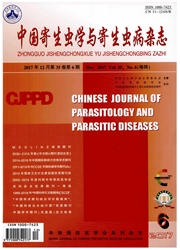

 中文摘要:
中文摘要:
目的分析日本血吸虫尾蚴感染小鼠体内髓源抑制性细胞(myeloid.derivedsuppressorcells,MDSC)的富集情况.初步探索其在抗血吸虫感染免疫中的作用。方法日本血吸虫尾蚴用腹部贴片法感染C57BL/6小鼠(20条/鼠)24只。感染后1、2、6和8周采集小鼠(各6只)外周血,感染6、8周组小鼠脱颈处死后取脾组织,制备单细胞悬液。各时段同时设健康对照组(各6只)。通过流式细胞术检测小鼠脾组织和外周血中的Gr-1+细胞、CD11b+细胞及MDSC比例。通过CD4+T细胞增殖抑制试验验证感染小鼠Gr-1+粒细胞的功能。结果感染后6周和8周组小鼠外周血MDSC、Gr-1+细胞、CD11b+细胞分别约占总单核细胞(MNC)的38.2%~57.8%和47.1%~77.6%,28.9%~44.6%和40-4%~72.9%,36.0%-48.1%和40-3%-68.3%,显著高于健康对照组(15.1%~20.4%,8.4%~17-3%,9.8%~22.6%)、感染后1周(16.2%~19.8%,13.0%~16.8%,17.6%~19.4%)及2周组(19.8%-29.5%,17.2%~22.2%和20.9%-33.3%)(P〈0.01)。而感染后1周、2周组与健康对照组相比,差异无统计学意义(P〉0.05)。脾组织与外周血中的MDSC、Gr—1+细胞、CD11b+细胞变化趋势一致。此外,从感染小鼠脾组织分离到的Gr-1+细胞显著抑制刀豆球蛋白诱导的健康小鼠的CD4+T细胞增殖能力。结论日本血吸虫感染可诱导小鼠体内MDSC富集,且感染Gr.1+细胞可抑制正常CD4+T细胞增殖。
 英文摘要:
英文摘要:
Objective To determine the accumulation of CDllb Gr-1+ myeloid-derived suppressor cells(MDSC) in Schistosoma japonicum-infected mice. Methods Twenty-four C57BL/6 mice were infected cutaneously with S. japon- icum cercariae. Peripheral blood samples were collected at 1, 2, 6 and 8 weeks post-infection (6 mice for each group). At 6 and 8 weeks post-infection, spleens were removed and a single-cell suspension was prepared. At the same time, 6 healthy mice each served as control. During the different stages of infection, the levels of MDSC, Gr-1+ cells, CDllb~ ceils in murine peripheral blood and spleen were detected by flow cytometry. The possible function of MDSC on T cells was evaluated by using a CCK-8 method and CFSE proliferation assay. Results At 6 and 8 weeks post-infection, the levels of MDSC (38.2%-57.8% and 47.1-77.6%, respectively), Gr-1~ cells (28.9%-44.6%, 40.4%-72.9%), and CDllb cells (36.0%-48.1%, 40.3%-68.3%) in infection group were significantly higher than that of the controls (15.1%-20.4%, 8.4%-17.3%, 9.8%-22.6%), and that of infection group at 1 week (16.2%-19.8%, 13.0%-16.8%, 17.6%-19.4%) and 2 weeks (19.8%-29.5%, 17.2%-22.2%, 20.9%-33.3%) post-infection (P〈0.01). No significant dif- ference was found in the levels of MDSC, Gr-1 cells, CDllb+ cells among infection group at 1 and 2 weeks post-infec- tion and control group. Moreover, the fluctuation trends of these cells in the spleens of infected mice were similar to those cells in peripheral blood (P〉0.05). Strikingly, the proliferation index of normal CD4+ T cells was significantly low-er after co-culture with Gr-1 + cells isolated from infected mice. Conclusion Schistosoma japonicum infection induces higher level of MDSC in mice, and Gr-1+ cells isolated from the infected mice can significantly inhibit the proliferation of the normal CD4+ T cells.
 同期刊论文项目
同期刊论文项目
 同项目期刊论文
同项目期刊论文
 Deposited eggs of Schistosoma japonicum in spleen : pathogen that induces apoptosis of splenic T cel
Deposited eggs of Schistosoma japonicum in spleen : pathogen that induces apoptosis of splenic T cel 期刊信息
期刊信息
